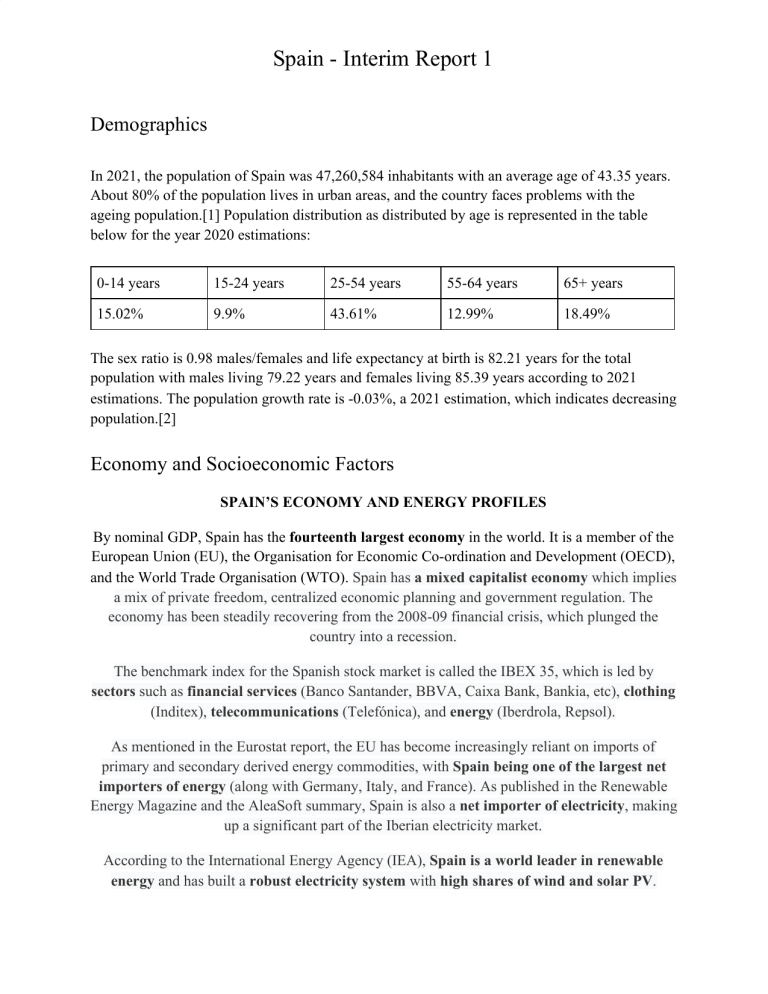
Spain - Interim Report 1 Demographics In 2021, the population of Spain was 47,260,584 inhabitants with an average age of 43.35 years. About 80% of the population lives in urban areas, and the country faces problems with the ageing population.[1] Population distribution as distributed by age is represented in the table below for the year 2020 estimations: 0-14 years 15-24 years 25-54 years 55-64 years 65+ years 15.02% 9.9% 43.61% 12.99% 18.49% The sex ratio is 0.98 males/females and life expectancy at birth is 82.21 years for the total population with males living 79.22 years and females living 85.39 years according to 2021 estimations. The population growth rate is -0.03%, a 2021 estimation, which indicates decreasing population.[2] Economy and Socioeconomic Factors SPAIN’S ECONOMY AND ENERGY PROFILES By nominal GDP, Spain has the fourteenth largest economy in the world. It is a member of the European Union (EU), the Organisation for Economic Co-ordination and Development (OECD), and the World Trade Organisation (WTO). Spain has a mixed capitalist economy which implies a mix of private freedom, centralized economic planning and government regulation. The economy has been steadily recovering from the 2008-09 financial crisis, which plunged the country into a recession. The benchmark index for the Spanish stock market is called the IBEX 35, which is led by sectors such as financial services (Banco Santander, BBVA, Caixa Bank, Bankia, etc), clothing (Inditex), telecommunications (Telefónica), and energy (Iberdrola, Repsol). As mentioned in the Eurostat report, the EU has become increasingly reliant on imports of primary and secondary derived energy commodities, with Spain being one of the largest net importers of energy (along with Germany, Italy, and France). As published in the Renewable Energy Magazine and the AleaSoft summary, Spain is also a net importer of electricity, making up a significant part of the Iberian electricity market. According to the International Energy Agency (IEA), Spain is a world leader in renewable energy and has built a robust electricity system with high shares of wind and solar PV. Spain - Interim Report 1 Notably, connections across borders are seen as imperative to take advantage of Spain’s renewable energy potential and liquefied natural gas regasification capacity, the highest in the EU. Interestingly, we see that El Hierro, of Spain’s Canary Islands, made headlines as being one of the world’s first energy self-sufficient islands. Total Final Consumption (TFC) by sector, Spain 1990-2018 We can observe that the Transport sector is the largest consumer of energy, followed by Industry, Residential and Commercial & Public Services sectors, with other sectors consuming considerably lower amounts in comparison. The following graphs represent total energy consumption – that is the sum of energy uses including electricity, transport, and heating. Many assume energy and electricity to mean the same, but electricity is just one component of total energy consumption. Spain: How much energy does the country consume each year? Spain - Interim Report 1 Spain: What sources does the country get its energy from? Spain - Interim Report 1 Spain: How much is consumption of energy sources changing each year? Spain - Interim Report 1 As observed from the above graphs, Spain has largely been trying to expand its usage of renewable energy sources over the last few decades, with a brief foray into nuclear energy while mainly increasing its consumption of energy from low-carbon sources, and reducing its heavy dependence on fossil fuels. However, the journey in Spain’s renewable energy story hasn’t been smooth. Spain’s aggressive goals, especially its investments in the renewable energy sector, were heavily subsidized by the government, but it fell into economic distress as a result. Specifically in 2013, the New York Times reported that the country decided to halt the unsustainable growth of its tariff deficit which had built up a mounting debt of about €26 billion euros, leaving the renewable energy sector to bear the brunt. Nonetheless, over time, the government has come around on its decisions and plans to make further commitments in the renewable sector, in a manner that is financially sustainable and enables Spain to fully exploit its advantages. LIVING STANDARD OF THE POPULATION. Education – In Spain, 59% of adults aged 25-64 have completed upper secondary education, much lower than the OECD average of 78%. In terms of the quality of the educational system, the average student scored 491 in reading literacy, maths and science in the OECD's Programme for International Student Assessment (PISA), slightly higher than the OECD average of 486. The Gross Domestic Product per capita in Spain was last recorded at 33349.70 US dollars in 2019. The GDP per Capita in Spain is equivalent to 264 percent of the world's average. Spain GDP per Capita 1960-2021 Spain - Interim Report 1 Spain GDP Growth Rate 1961-2021 Human Development Index – The HDI value for Spain for 2019 is 0.904 putting it in the very high human development category, ranking it at no. 25 out of 189 countries. Spain - Interim Report 1 Income Inequality – Gini Coefficient of Different Countries (Spain highlighted in red having a Gini Coefficient of 0.330). Another indicator to measure Inequality would be Inequality-Adjusted HDI (IHDI) which takes the score down from 0.904 to 0.783 Employment – About 62% of people aged 15-64 in Spain have a paid job, below the OECD employment average of 68%. Unemployment, as a percentage of the total labour force, stands at about 14%. According to the OECD Better Life Index, the long-term unemployment rate in Spain stood at 7.7% Spain - Interim Report 1 Geography and Ecosystems Spain is located in southwest Europe bordering the Mediterranean sea and the North Atlantic Ocean. The Kingdom of Spain also has territories in Morocco as well as the Canary and Balearic Islands, making it the second largest country in Europe behind France. The region covers roughly 505000 sq km with long hot summers and moderate cloudy weather along the coast. A maximum of 36 degrees and an average temperature of 19 degrees Celsius paired with the largest coastline in Europe, there is no bad time to visit Spain. As shown by the demographic below, only 20 percent of Spain's population lives in rural areas (9 million) however, 23 percent of land in Spain is considered arable, producing over $50 billion in agricultural goods which accounts for 15% of their GDP. The main agricultural exports include strawberries, lemons, and oranges. The Nation is home to some of the largest European deposits of gold, mercury, tungsten, and uranium. Spain - Interim Report 1 Degree of pollution: “15 million Spaniards are breathing air the EU considers polluted” Half of Spain is wreathed with air containing imprudent levels of particulate matter, Nitrogen dioxide and Ozone. - Cause behind the existence of these pollutants 1) NO2: ● caused mainly due to traffic (a predominant problem in big cities) [50% of road traffic of NO2 emissions] ● NO2 is a byproduct of combustion at high temperatures, for instance in car motors and electricity plants. ● To protect our health, the EU stipulates that the annual average of NO2 should not exceed 40 micrograms per cubic meter. In Madrid, 62 micrograms were registered last year – 55% over the limit; and in Barcelona, the figure was 59 micrograms – 47.5% over. ● There is a second emergency limit linked to spikes of NO2 which are common in Madrid and which happen when the air is stagnant. The capital was the only place in Spain that exceeded this emergency limit last year, which is set at 200 micrograms per cubic meter an hour, no more than 10 times during the year. 2) PM10 (particulate matter): ● Particulate matter consists dust, ash, soot and similar substances ● Main source: traffic, central heating systems, industry and construction and demolition works. ● Of the 126 zones in Spain, 36 have illegal levels of ozone gas. 3) Ozone: ● This pollutant is linked to the others, which is prevalent during hot weather and can spread long distances – which is why areas where the air might be assumed to be clean, such as Madrid’s Sierra Norte, can be highly contaminated. ● Of the 126 zones in Spain, 36 have excessive levels of ozone gas. The more cars and pollution in the cities, the bigger the ozone problem in the outlying areas. Sierra Norte in the region of Madrid was one of the worst hit areas. Political Situations: As its official name - the Kingdom of Spain - hints at, Spain is a constitutional monarchy with its mainly ceremonial Head of State being King Felipe VI, ruling the otherwise democratic nation. Spain follows the basic separation of powers through the legislative, executive, and judicial branches. (CIA, 2021). The Spanish Socialist Workers Party or PSOE has been in power since June 2018, with its party leader and Spanish Prime Minister Pedro Sanchez having successfully led a vote of no confidence against the previous People’s Party Prime Minister and party rule. (Minder, 2018) Spain - Interim Report 1 A major reason for the removal from office of the People’s Party was due to court proceedings revealing corruption on behalf of People’s Party members, which, coupled with growing left-wing support, led to this shift in government. As a left-wing government, the PSOE is aware of issues such as global warming and making strides for sustainability. Spain ,being especially hit by climate change through warmer temperatures and lower rainfall, has led to new environmental policy plans being introduced in 2018, which aims to ”draw 75 percent of its electricity from renewables by 2030, rising to 100 percent by 2050.” (Heggie, 2020) According to the same National Geographic report, it also aims to “decarbonize” and slash GHG emissions by 90%. (Heggie, 2020) The new government has decreased fossil fuel licenses and also decreased and eventually banned the sale of fossil fuel cars. (Sanchez & Planelles, 2018) The government has also made further commitments to invest in renewable energy. Most major corruption cases have been perpetrated by the opposition and not the party-in-power (the right-wing People’s Party) and thus, corruption is not a major concern for sustainability. (Rubio, 2020) These major strides towards sustainability in the form of sustainable energy are promising; however, more recent political issues such as the independence movement of the Catalonia region of Spain, as well as recent elections leading to PSOE no longer having a majority, coupled with the COVID-19 pandemic means that for now the Spanish government while supportive of sustainability, may have other things in mind. References CIA. (2021, March 8). Spain. Retrieved from CIA World Factbook: https://www.cia.gov/the-world-factbook/countries/spain/ Heggie, J. (2020, April 23). Spain: taking sustainable energy to the next level. Retrieved from National Geographic: https://www.nationalgeographic.com/science/article/partner-content-setting-standard-forsustainability Minder, R. (2018, june 1). Spain’s Prime Minister, Mariano Rajoy, Is Ousted in No-Confidence Vote. Retrieved from New York Times: https://www.nytimes.com/2018/06/01/world/europe/spain-mariano-rajoy-no-confidence.h tml Rubio, V. L. (2020, January 29). Corruption in Spain – A Brief Analysis of High-Profile Cases and Spanish Authorities’ Anticorruption Efforts. Retrieved from Kroll: https://www.kroll.com/en/insights/publications/compliance-risk/spain-corruption-analysis Spain - Interim Report 1 Sanchez, E., & Planelles, M. (2018, November 18). Spanish government planning to ban sale of gasoline, diesel cars from 2040. Retrieved from El Pais: https://english.elpais.com/elpais/2018/11/13/inenglish/1542118484_563478.html Shubert, A. (2021, March 14). Spain. Retrieved from Encyclopedia Britannica : https://www.britannica.com/place/Spain Spain : Introduction, Broad College of Business, Michigan State University. Retrieved from:https://globaledge.msu.edu/countries/spain/#:~:text=Spain%20has%20a%20mixed %20capitalist%20economy%20in%20which,is%20a%20member%20of%20the%20Euro pean%20Union%20%28EU%29. World Economic Outlook Database, International Monetary Fund (October 2020). [Online Resource] Retrieved from: "World Economic Outlook Database, October 2020". IMF.org. International Monetary Fund. Hannah Ritchie and Max Roser (2020) - "Energy". Published online at OurWorldInData.org. Retrieved from: 'https://ourworldindata.org/energy' [Online Resource] https://ourworldindata.org/energy/country/spain?country=~ESP#per-capita-how-much-en ergy-does-the-average-person-consume Spain continues as a net importer of electricity from France in 2018, AleaSoft Energy Forecasting. Retrieved from: https://aleasoft.com/spain-imports-electricity-france-2018/ REM. (2018, 6 December). Renewable Energy Magazine, Panorama, Retrieved from: https://www.renewableenergymagazine.com/panorama/spain-continues-as-net-importer-o f-electricity-20181206 Energy Consumption in Spain, World Data (2016). Published online at worlddata.info. [Online Resource] Retrieved from: https://www.worlddata.info/europe/spain/energy-consumption.php#:~:text=Spain%20cou ld%20provide%20itself%20completely%20with%20self-produced%20energy.,productio n%2C%20imports%20and%20exports%20play%20an%20important%20role. Spain GDP Per Capita 1960-2021, MacroTrends (2021). Retrieved from: https://www.macrotrends.net/countries/ESP/spain/gdp-per-capita Spain GDP Growth Rate 1961-2021, MacroTrends (2021). Retrieved from: https://www.macrotrends.net/countries/ESP/spain/gdp-growth-rate Spain - Interim Report 1 Income Inequality, Inequality, 60 Years Data, Organisation for Economic Co-Operation and Development. [Online Resource] Retrieved from: https://data.oecd.org/inequality/income-inequality.htm Organisation for Economic Co-operation and Development Better Life Index, Spain. [Online Resource] Retrieved from: http://www.oecdbetterlifeindex.org/countries/spain/ Human Development Report 2020 , The Next Frontier: Human Development and the Anthropocene, United Nations Development Programme, Spain. [Online Resource] Retrieved from: http://hdr.undp.org/sites/all/themes/hdr_theme/country-notes/ESP.pdf Energy production and imports (June 2020), Statistics Explained, Europa.EU. Retrieved from: https://ec.europa.eu/eurostat/statistics-explained/index.php?title=Energy_production_and _imports&oldid=498607#The_EU_and_its_Member_States_are_all_net_importers_of_e nergy Andrés Cala (2013, 8 October). Renewable Energy is taking a beating in Spain. Retrieved from: https://www.nytimes.com/2013/10/09/business/energy-environment/renewable-energy-in -spain-is-taking-a-beating.html Spain, International Energy Agency. Retrieved from: https://www.iea.org/countries/spain [1] J. Doe, “Population: Demographic Situation, Languages and Religions,” Eurydice European Commission, 22-Oct-2020. [Online]. Available: https://eacea.ec.europa.eu/national-policies/eurydice/content/population-demographic-situa tion-languages-and-religions-79_en. [Accessed: 15-Mar-2021]. [2] Central Intelligence Agency. [Online]. Available: https://www.cia.gov/the-world-factbook/countries/spain/. [Accessed: 15-Mar-2021]. European Commission. (2020, June). Statistical factsheet. https://ec.europa.eu/info/sites/info/files/food-farming-fisheries/farming/documents/agri-stat istical-factsheet-es_en.pdf PELAEZ TORRES, V. P. T. (2021, February 10). Spain. Geography. https://kids.nationalgeographic.com/geography/countries/article/spainred2000 ,(2020, February 21). Spain - Interim Report 1 Climate and Weather: Average temperatures in Spain. Climate Spain. https://www.red2000.com/spain/primer/clima.html


